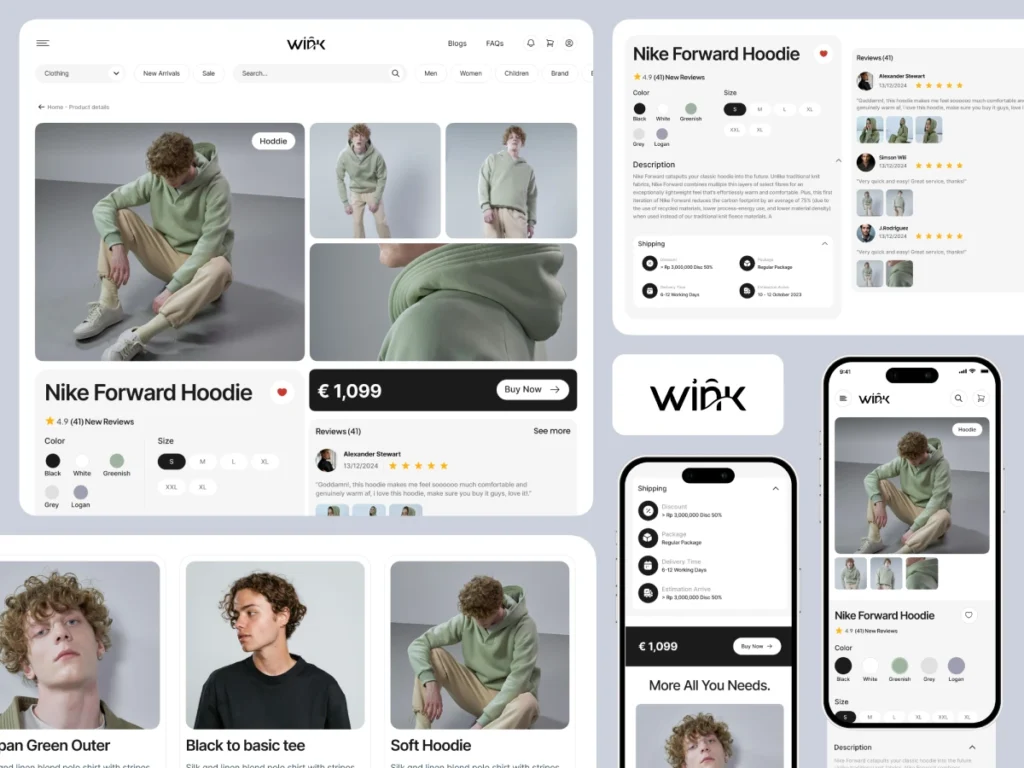What makes a website good and engaging?
What’s the first thing that catches your eye when you land on a website? The appearance, right?
An appealing design leaves a strong impression. However, an attractive website is not just visually pleasing, it must also be functional and user-friendly.
There are numerous aspects to consider to capture visitors’ attention and keep them engaged.
Let’s look into the essential elements that make a website design truly attractive and effective.
1. Visual Harmony and Simple Navigation
-Steve Jobs-
A well-crafted visual design must create harmony.
Choosing harmonious colors, appropriate typography, and effective use of white space can enhance readability and encourage visitors to spend more time on your site.

Option for contrasting color combinations to ensure the text is easy to read. For instance, dark text on a light background or vice versa is highly recommended.
Utilize clear fonts and appropriate sizes, and ensure ample spacing between paragraphs and other elements to improve reading comfort.
“Close to 50% of consumers evaluate a site's trustworthiness based on its visual features, including the design layout, color scheme, and typography.” (Stanford)
Visitors should easily locate information. Clear menus, visible links, and a logical structure will assist users in navigating your website smoothly.
Intuitive navigation is key to creating a functional website. Poor navigation can lead to frustration and result in visitors leaving without finding what they need.
2. Responsiveness, Adaptability, and Page Load Speed
Fun fact: 53% of users will leave a site that takes longer than 3 seconds to load.
With the rising use of mobile devices, responsive design and fast page loading speed have become essential.
Responsive design makes your website looks great on variety of devices, from smartphones, tablets to desktops. This not only enhances user experience but can also improve your SEO rankings on search engines.

Ethan Marcotte, a pioneer of responsive design, states, “Responsive design is about providing the best experience for every user, regardless of the device they are using.”
Page load speed is another critical factor that cannot be overlooked. Google prioritizes sites that load quickly.
Ensuring your website is fast and efficient not only enhances user experience but also impacts conversion rates.
To achieve optimal speed, consider compressing images, minimizing heavy scripts, and utilizing browser caching.
You can analyze and enhance your site’s performance by using Google Page Speed Insights.
3. The Importance of Call to Action in Design
Call to Action (CTA) is a crucial element in design that guides users to take specific actions, such as signing up for newsletters, downloading content, or purchasing products. Without clear CTAs, visitors may feel confused about their next steps.
According to research, 70% of small business websites lack a Call to Action (CTA) on their homepage.

Use engaging and urgent language, such as “Sign Up Now” or “Get Discount.”
Users tend to interact with elements that are intuitively designed and visually appealing. Choose eye-catching colors and position them strategically for easy access, such as at the top of the homepage or within relevant content.
By optimizing CTAs, you can enhance user interaction and satisfaction.
4. Keep It Simple, Fresh, and Quality Content
A survey found that 84.6% of web designers think small businesses most commonly make the mistake of having a cluttered design.
A simple, concise, and fresh design allows users to focus on the core content, as expressed.

The importance of delivering information that is brief and to the point. In a fast-paced world, people tend to be impatient and seek information quickly. Therefore, create content that is direct and straightforward.
-Jakob Nielsen-
Additionally, high-quality content should always be updated to remain relevant and engaging to encourage repeat visitors. Blogs with informative, interesting, and easily comprehensible content can generate more links than those without.
Content is king, so you have to ensure that every piece of published content adds value and provides useful information.
5. SEO
-Neil Patel-
Combining attractive design with effective SEO strategies is key to creating a website that is not only visually stunning but also reaches a broader and targeted audience.
As stated by HubSpot study, 75% of users don’t scroll to the second page of Google search result, which is why ranking on the first page is so important.
Design elements to consider for supporting SEO:
1. Page Speed and Responsiveness
Page load speed and responsive design, particularly for mobile access, are prioritized by Google due to the increasing number of users accessing the internet via mobile devices.
"More than 54% of all internet activity worldwide comes from mobile devices.” (Statista)
2. SEO-Friendly URL Structure
Clear and descriptive URLs will help search engines understand your content. Utilize relevant keywords in your URLs and avoid unnecessary characters.
3. Proper Use of Headings
Correct use of headings (H1, H2, H3) not only helps structure content but also signals to search engines about the relevance and hierarchy of information on your page. Ensure to use keywords in headings to improve visibility.
Conclusion
Creating a good and engaging website is no easy feat, but by considering the aspects mentioned above, you can enhance the positive experience for users.
Good design is not solely about aesthetics, it also facilitates visitors in obtaining the information they seek.
So, make sure your website is not only visually appealing but also functions effectively. Happy designing!

